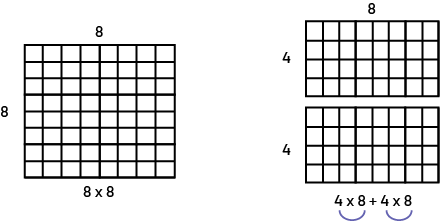C2.2 Determine whether given sets of addition, subtraction, multiplication, and division expressions are equivalent or not.
Activity 1: Compare Expressions with Arrays

Geometric motifs and the corresponding equations. The first is a vertical grid of 15 squares. The equation below is 5 times 3. Next is a horizontal grid of 15 squares. The equation below reads 3 times 5. Next is a series of mosaic circles. It is aligned like the first grid but instead of a grid there is a series of circles. The equation reads 5 times 3. Finally, 15 circles in 3 rows placed horizontally. The corresponding equation reads 3 times 5.
Introduction to Arrays
Before beginning, prepare concrete, semi-concrete materials that represent an array (e.g., juice box crate, egg carton, chocolate bar, chairs arranged in rows and columns, illustrations). Present the materials to the students and count the rows and columns with them.
Next, observe pictures of arrays (e.g., pictures of boxes filled with juice boxes, chocolate bars grouped in rows, fruit or vegetable displays). Then count the rows and columns in these arrangements. Make the connection to a 10 frame.
Have students design an array with 12 squares on graph paper. Compare the different possible arrangements (4 rows and 3 columns; 3 rows and 4 columns; 2 rows and 6 columns; 6 rows and 2 columns; 1 row and 12 columns; 12 rows and 1 column).
Point out that the shape is always rectangular and that the number of spaces is the same in each row (e.g., 2 spaces in each of 6 rows) and in each column (e.g., 6 spaces in each of 2 columns). Invite students to identify other numbers with which similar arrays can be made.
Activity
In pairs, have students use arrays to determine whether these two expressions are equivalent.
Provide each team with large sheets of graph paper and scissors.
8 × 8

For example, students could cut out an array as follows:
 A grid with 64 squares. 8 vertically, and 8 horizontally. An equation below shows 8 times 8. To the right there are two grids. 4 vertically, and 8 horizontally. An equation below shows 4 times 8 plus 4 times 8.
A grid with 64 squares. 8 vertically, and 8 horizontally. An equation below shows 8 times 8. To the right there are two grids. 4 vertically, and 8 horizontally. An equation below shows 4 times 8 plus 4 times 8.
Share with the students by displaying some examples of arrays to show that the two expressions are equivalent since the quantity of squares remains the same if cut in half.
Ask them to find other expressions and illustrate them to show that the strategy works for different expressions.
Example 1

Without doing calculations, students may notice that the numerical expression on the left is quivalent to the expression on the right of the equal sign. Next, ask students to represent the number sentences using open arrays.
Example 2

Ask students to create other expressions that represent an equivalence that their peers can prove.
Example 3

Source: translated from Guide d’enseignement efficace des mathématiques de la maternelle à la 3e année, Modélisation et algèbre, Fascicule 2, Situations d'égalité, p. 73-76.
Activity 2: Compare Expressions with a Balance Scale
Introducing a Number Balance
Introduce the different parts of the number balance using appropriate terms (e.g., lever, fulcrum, tab).
Place two tabs at a number to the left of the lever (for example, at number 3). Ask students to describe the position of the lever.
Ask the following question:
- How can we balance the scale?
Highlight to students that:
- the lower part of the lever represents the higher quantity;
- in this situation, an amount must be added to the right side of the lever to restore the balance;
- the balance is in equilibrium if the quantities are equal on both sides of the lever;
- on each side of the scale, the added quantities can be represented by different numerical expressions such as 2 × 3, 5 + 1, 3 × 2, 1 + 1 + 4.
Activity
Introduce this situation to students:
Lucie placed a tab on the number 8 on the left side of a mathematical scale and another tab on the number 4 on the right side of the scale.

What does she need to do to create an equal situation if she has to perform at least one operation on each side of the scale? Model a possible solution. For example, move the tab on the left side of the scale from 8 to 6 (- 2) and add 2 to the right side.

Ensure that students see that the balance is now in equilibrium and that it now describes a situation of equality.
For each step, write a number sentence:
8 ≠ 4
8 - 2 = 4 + 2
6 = 6
Ask students to repeat the process to find another solution.
Source: translated from Guide d’enseignement efficace des mathématiques de la maternelle à la 3e année, Modélisation et algèbre, Fascicule 2, Situations d'égalité, p. 78-79.
